How To Write Notes That Convert - In One Minute (or Less)
Use AI + metrics to reverse-engineer what already works - without burning out
You spend hours crafting Notes.
Trying to be original. Punchy. Valuable.
And then… they land with a soft thud.
A few likes. No shares. No subs.
And no idea why.
I used to think the problem was me.
Maybe I wasn’t “good enough” at writing.
Those other writers just knew something I didn’t.
But after 777 Notes and 29 months of writing and building in public, I’ve learned something different:
You already have the answers. You just don’t have the fast feedback loop.
✅ Your best-performing Notes
✅ Your conversion spikes
✅ Your viral hooks and hidden gems
The trick isn’t writing more.
It’s reusing what already worked, with enough clarity and confidence to do it again in one minute.
That’s why I’m building Substack Pro Studio — a tool for creators who are tired of winging it.
Why Most Notes Don’t Convert
There’s no shortage of writing advice out there.
But most of it is built on vibes, not data and evidence.
And Substack’s built-in tools? They’re a start, but they don’t show the full picture, at least not in a way that’s actionable.
Here’s what I’ve learned the hard way:
We chase virality, not evidence
We don’t know which hooks actually drove conversions
Feedback comes too slowly to matter
Metrics exist, but there’s no map
“You’re not bad at writing. You’re just flying blind.”
The Conversion Formula
After analyzing 1.7 million+ Notes, here’s what kept showing up again and again:
High-converting Notes share 3 traits:
A hook in the first 10 words that makes you stop scrolling
A payoff by line two — the “so what” is immediate
An emotional tilt — something empowering, surprising, or deeply human
This might sound obvious.
But when you’re in the weeds, obvious gets buried.
Let me show you two Notes of mine that prove the point.
Note #1 — Focused on essay length and engagement
🔢 Metrics: 1165 clicks, 12 shares, 23 new subscribers, 5 followers
Note #2 — Tighter, punchier, curiosity-led
🔢 Metrics: 2068 clicks, 13 shares, 17 subscribers, 2 followers
The second Note drove more traffic. The first one converted better.
Why?
When I ran them through an AI analysis prompt, the pattern was clear:
Note #1 had a stronger narrative and clarity.
Note #2 had higher click potential and stronger emotional payoff.
AI can provide you with more insights, like the one below:
AI can offer suggestions on how to improve or provide different versions of the same idea:
Now here’s the good part:
I asked AI to rewrite Note #1 using the emotional tone and pacing of Note #2.
The result?
Sharper. More relatable. More likely to convert.
You can do the same, fast.
Here's how.
How to Do This in 60 Seconds (or less)?
Here are the three steps using my new Substack Pro Studio tool, which I’m currently building.
Click AI Assistant and select “Optimized Combined Prompt.”
Copy the prompt and paste it into ChatGPT
Click Analytics and select Segment Actions
By default, your Notes are sorted by Conversions
Select two top-converting Notes and copy them with metrics to the clipboard
Paste into ChatGPT and submit the request
Click Kanban and “Add Note” on the Draft columns
Paste the generated Note draft from ChatGPT in the editor window
Edit to your satisfaction and press the Esc key to save
Drag and drop to the Scheduled column, and your Note is scheduled
You just created a high-performing Note in under a minute.
Here is a video to prove that this can be done in less than one minute
(Two, if ChatGPT is having a bad day 😄)
What to Look For (and Steal From Yourself)
I used to scroll through my metrics with this weird mix of guilt and confusion.
Some Notes would spike. Others flopped.
And I'd think, “Okay… but why?”
Eventually, I stopped looking for what was clever and started looking for what was effective.
Here’s what I pay attention to now:
Intros that hook fast → Steal the exact sentence structure
Pacing tricks that hold attention → Are you building curiosity every 2 lines?
Next steps that converted subs → Copy the tone, the placement, even the emojis
Topics that quietly drove conversions → Not the most viral ones
This isn’t about copying yourself word-for-word.
It’s about reusing the structure that already proved it can carry weight.
Turn This Into a Weekly Habit
If you’re anything like me, you’ve been promised a dozen “simple creator habits” that just become yet another task in your overloaded week.
So I won’t pretend this is magic.
However, I will say that this habit has changed how I write.
This one stuck — because it’s simple, short, and outcome-driven.
Every Friday (before I let the week drift away), I do 4 things:
Open my Analytics dashboard
Filter Notes by conversions - not likes, not reactions, but actual subscriber growth
Pick my top 3 performers
Use AI to break them down, then reuse what works
Structure
Emotion
Topic angle
Audience insights
Then I schedule 3 to 9 more Notes using the same skeleton.
No second-guessing. No starting from scratch.
🕒 Time required: 4 minutes
📈 Output: 3 to 9 data-backed Notes you actually feel good about publishing
The result?
From 706 to 875 subs in 30 days
24% growth month-over-month
You don’t need a fancy “content strategy.”
You need a system that makes clarity feel easy and writing feel worthwhile again.
Final Thought
I used to think the answer was “write better.”
Wittier hooks. Deeper insights. Smarter formats.
But here’s what I’ve learned the hard way:
Write the same thing, better.
Not “from scratch,” but using the signal
You’ve already written something that worked.
Now, let’s build on it and do it under a minute.
Want to Try It?
I’m building the Substack Pro Studio for creators like me - and maybe like you:
Tired of guessing
Craving for clarity
Done wasting time writing things no one sees.
If that resonates, you should subscribe and get notified of the Substack Pro Studio the moment it’s ready.
Free Resources
Here is the AI prompt I used above to analyze and compare my Notes.
You can try it yourself, for free, using your favorite AI tool.
Works with ChatGPT, Claude, and Gemini.
✨ Optimized Combined Prompt (Comparison)
“Please compare these Substack Notes in terms of:
- Hook strength and headline effectiveness
- Shareability, quotability, and restack potential
- Emotional appeal and narrative tone
- Value clarity and takeaway strength
- Positioning: Is it differentiated from similar content?
- Audience fit: Does it reflect the reader’s language, mindset, or struggle?
- Pacing and structure: Is it optimized for scroll-to-end retention?
Then analyze how these factors may explain the differences in performance (clicks, conversions, reactions).
Finally, give me 3 concrete suggestions I can apply to improve my lower-performing Note — and optionally, rewrite it in the style or tone of the higher-performing one to boost engagement and growth.”
✨ Optimized Prompt (Single Note)
Prompt:
“Can you analyze this Substack Note for:
- Headline and hook strength
- Emotional pull and narrative voice
- Value clarity (what’s the insight or takeaway?)
- Audience resonance (does it speak to their identity/problem?)
- Shareability (is there anything restackable, quotable, or forward-worthy?)
- Scroll-through strength (pacing, formatting, curiosity loops)
- Differentiation (could only I have written this?)
Then provide a revised version that retains the core message but improves clarity, engagement, and growth potential.
My audience is
[describe audience — e.g. burnt-out solo creators trying to build a second brain in public].
My goal is to grow my reach and attract aligned subscribers.”




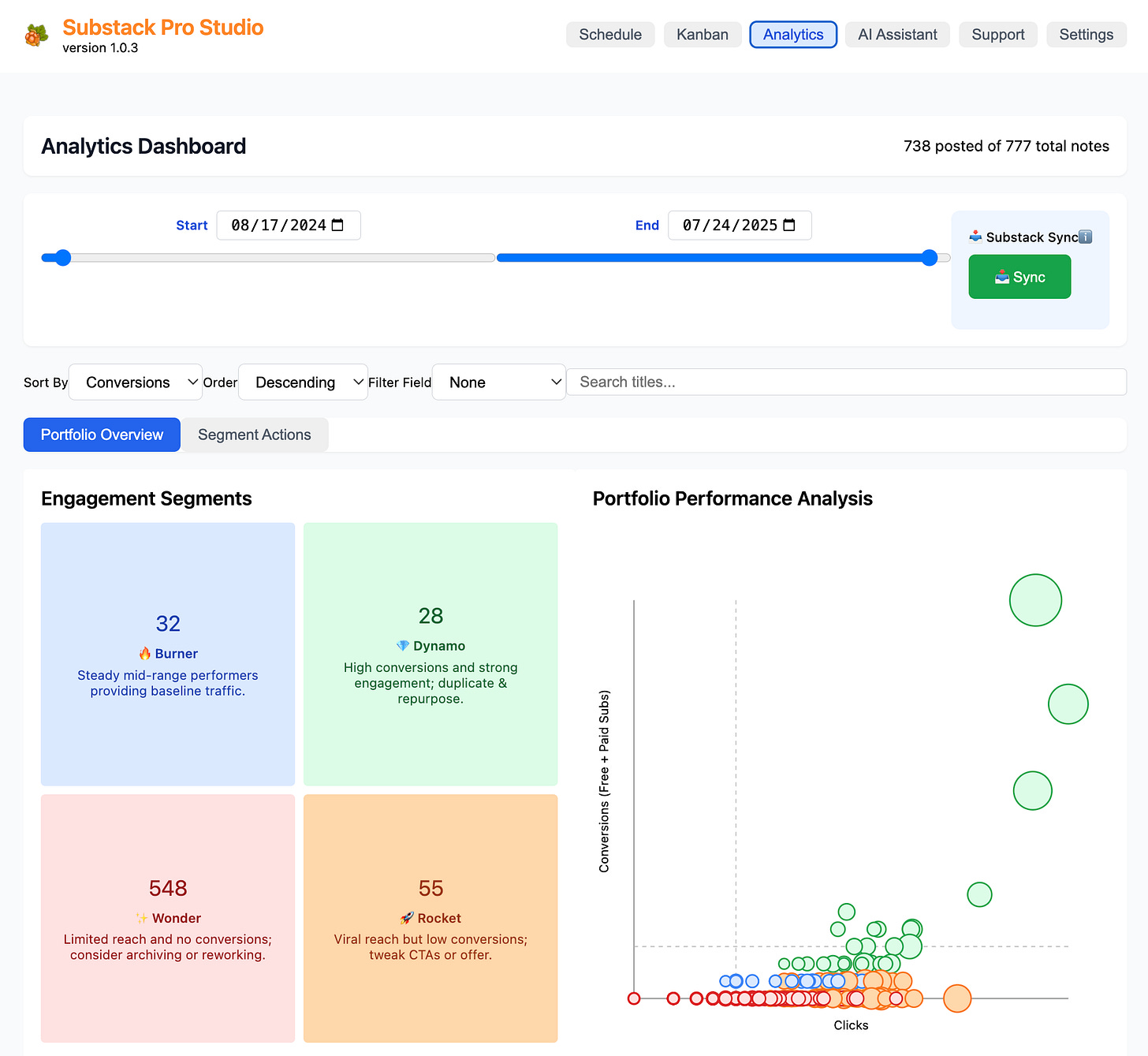
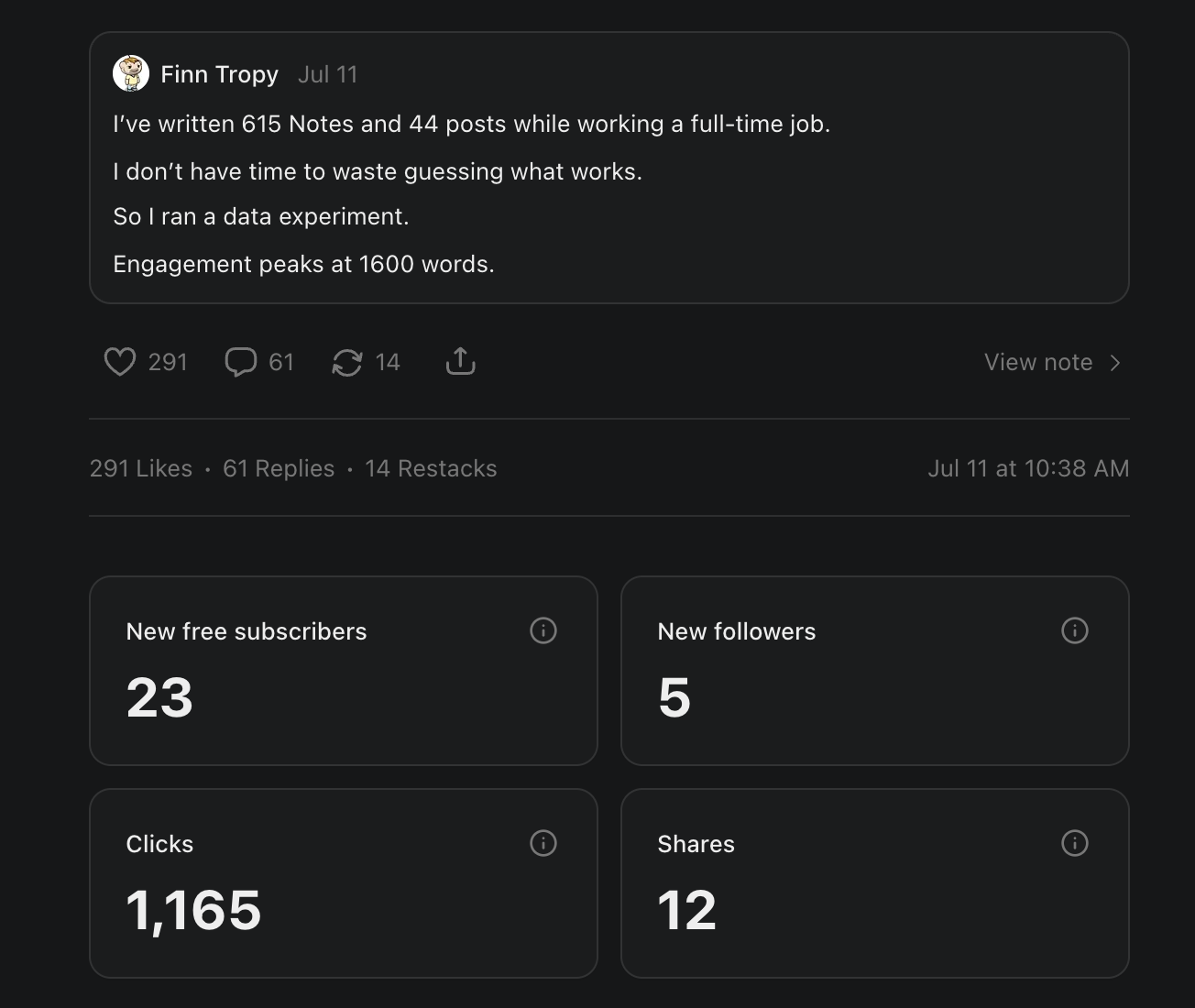
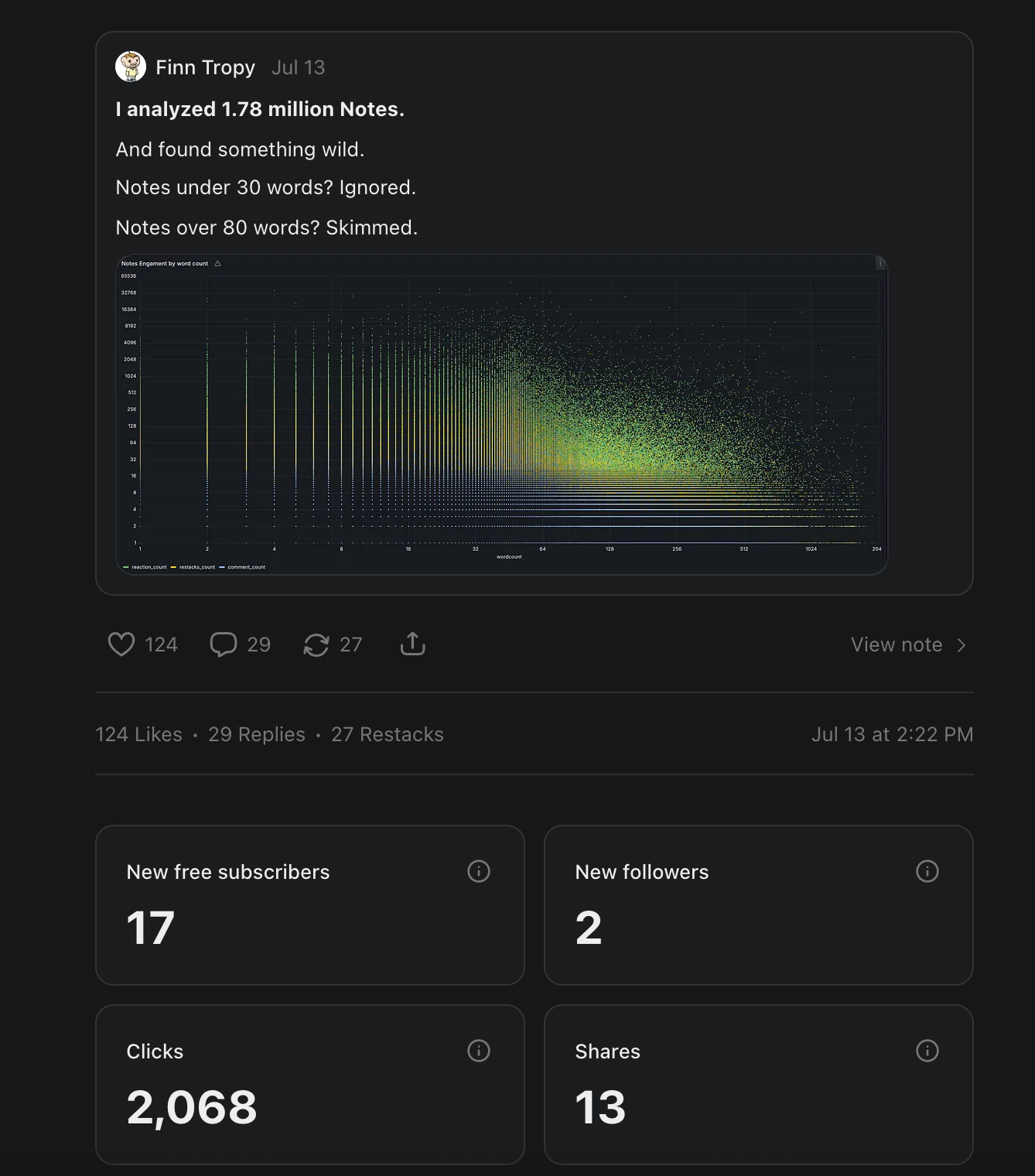
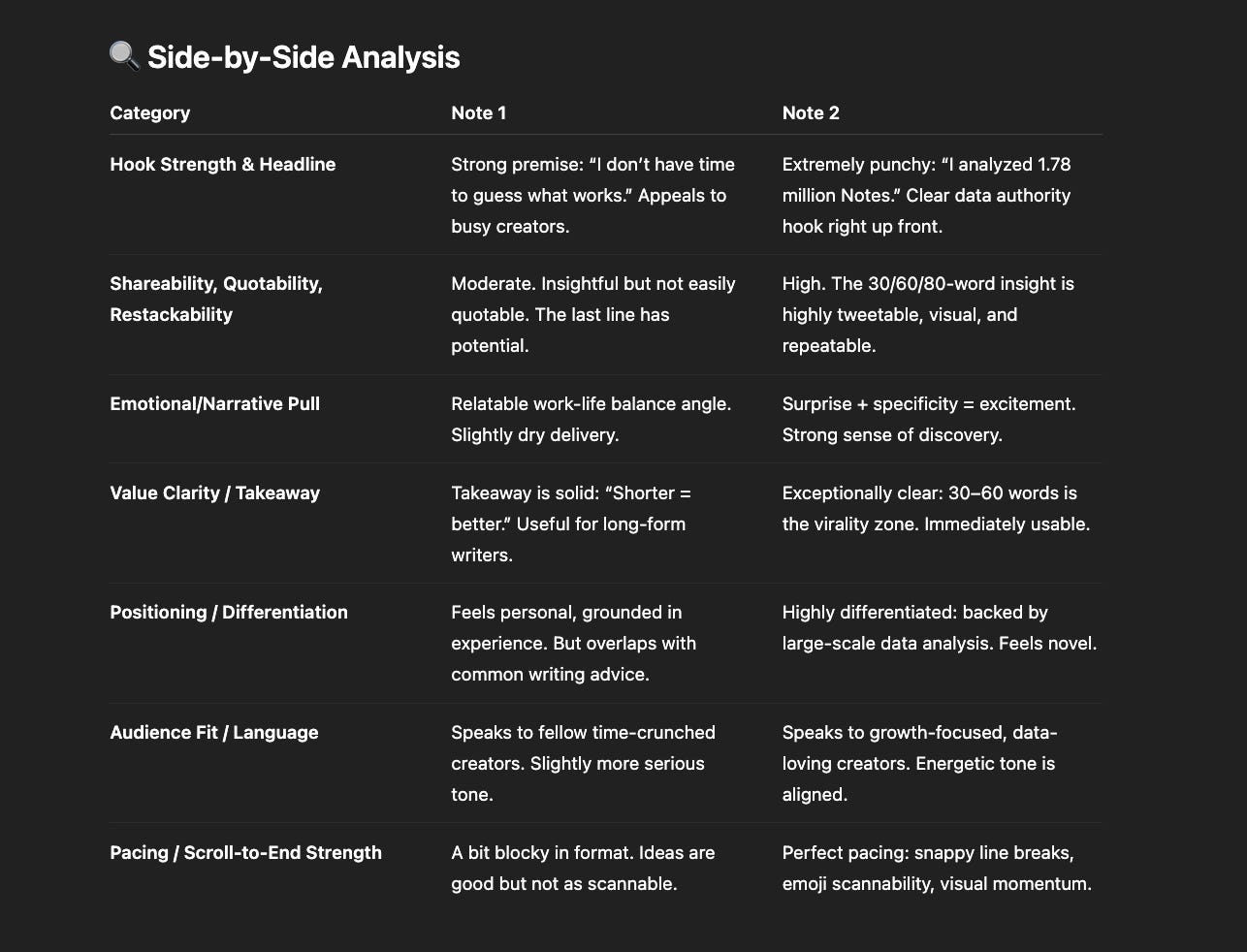
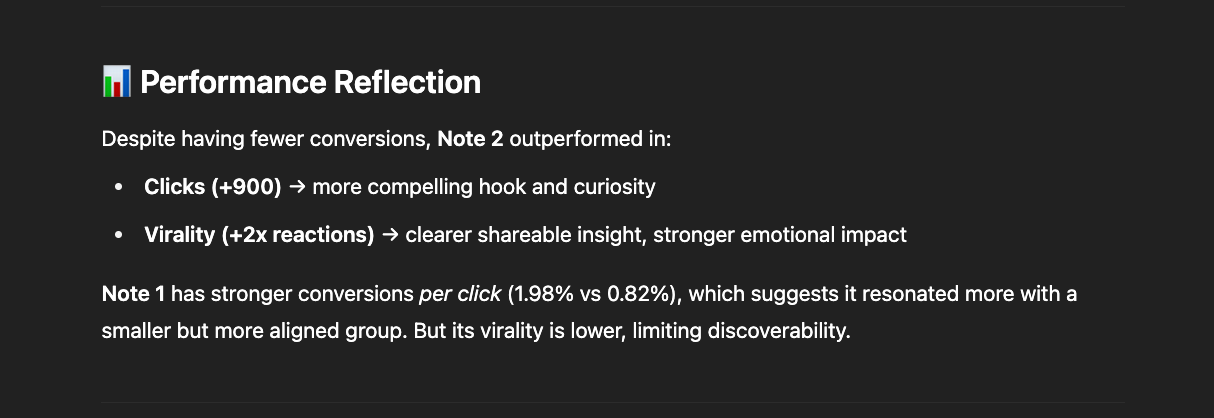

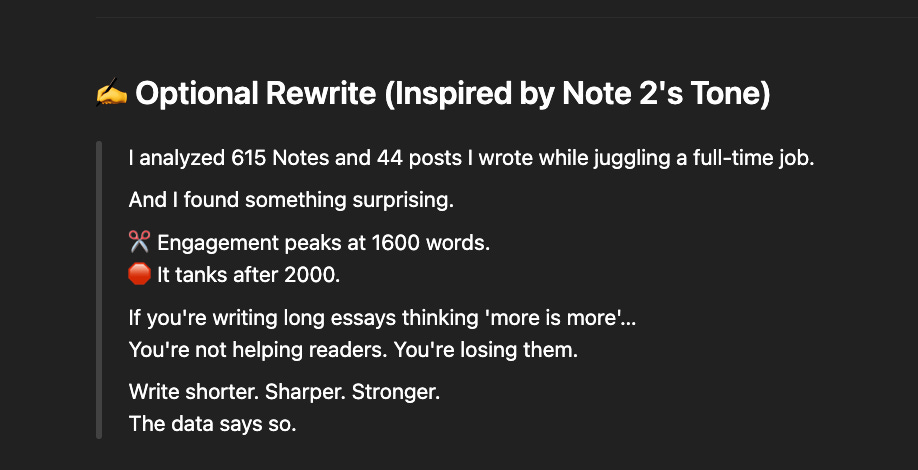
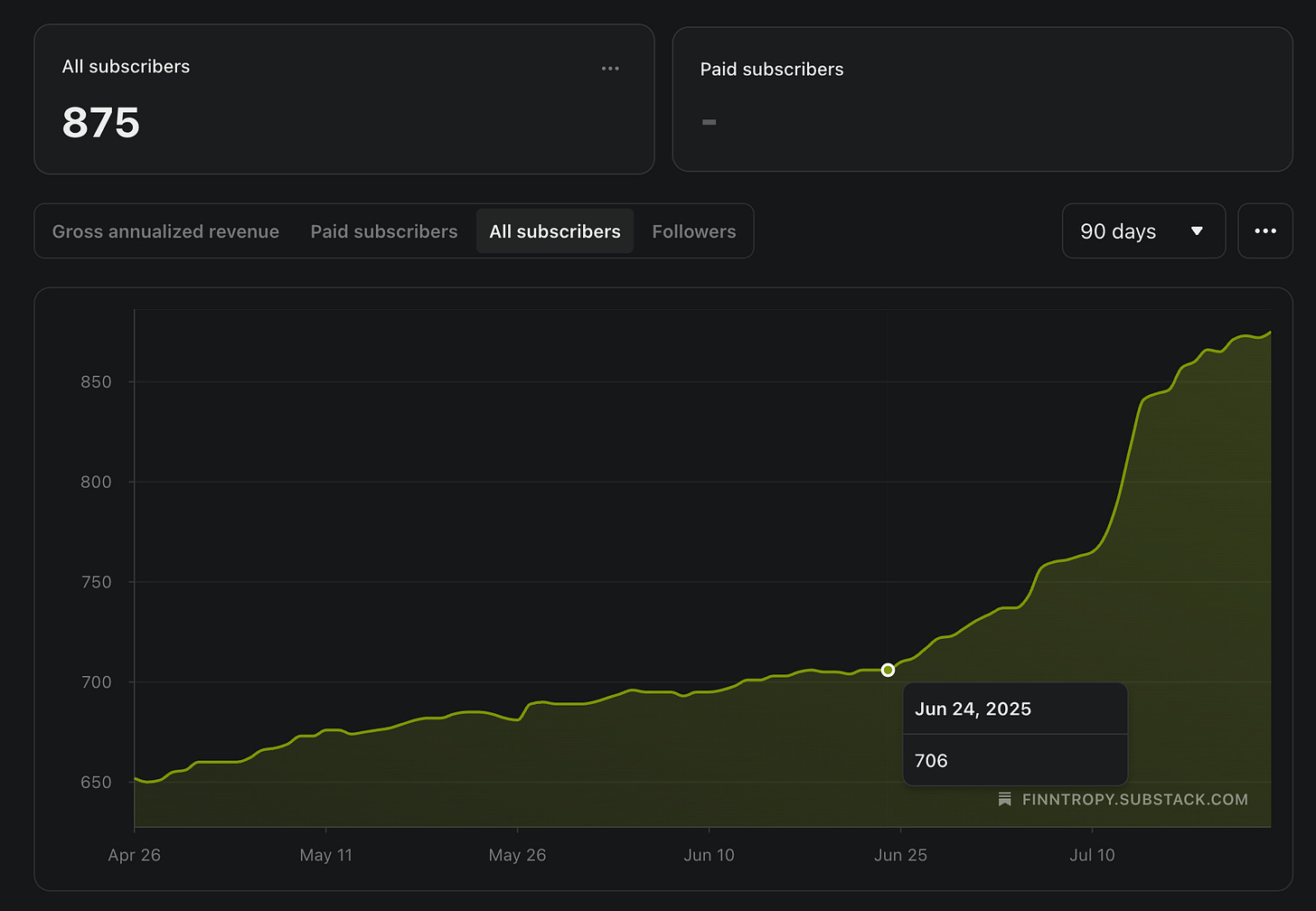
Brilliant perspective! This reminds me of Clayton Christensen's disruption theory in practice. This approach saved us months of iteration.
Where can I find this awesome tool of yours @Finn Tropy ?